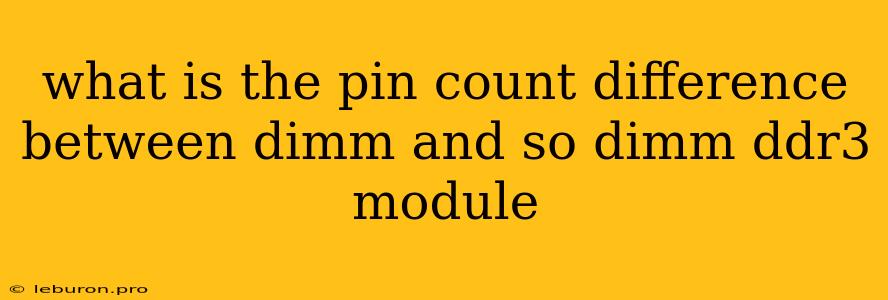Understanding the Pin Count Difference Between DIMM and SO-DIMM DDR3 Modules
The world of computer hardware can be complex, and understanding the differences between various components is crucial for building or upgrading a system. One such area of confusion is the distinction between DIMM and SO-DIMM DDR3 modules, particularly when it comes to their pin counts. While both are types of memory modules used in computers, they differ in size, pin count, and intended applications. This article will delve into the pin count difference between DIMM and SO-DIMM DDR3 modules, explaining the reasons behind the disparity and shedding light on their respective uses.
DIMM: The Standard Memory Module
DIMM (Dual In-line Memory Module) is the standard memory module used in desktop computers. It features a larger form factor and a higher pin count compared to its smaller counterpart, SO-DIMM. A typical DIMM DDR3 module boasts 240 pins, which are arranged in two rows on each side of the module. These pins are responsible for transferring data between the memory module and the motherboard's memory controller. The large size and high pin count of DIMMs allow for faster data transfer rates and support higher memory capacities.
SO-DIMM: The Compact Memory Module
SO-DIMM (Small Outline DIMM) is a smaller version of the DIMM designed for use in laptops, mini PCs, and other compact systems. As the name suggests, SO-DIMMs have a smaller form factor than DIMMs, enabling them to fit within the constraints of smaller devices. Consequently, SO-DIMM DDR3 modules also feature a lower pin count, typically 204 pins. The reduced size and lower pin count of SO-DIMMs are a trade-off for their compact size and compatibility with smaller motherboards.
The Pin Count Difference Explained
The key difference between DIMM and SO-DIMM DDR3 modules lies in their pin count. As mentioned earlier, DIMMs have 240 pins, while SO-DIMMs have 204 pins. The difference in pin count is not just a matter of aesthetics but reflects a fundamental difference in their design and intended usage.
The lower pin count of SO-DIMMs allows them to be physically smaller than DIMMs. This reduction in size is crucial for accommodating memory modules within the limited space of laptops and other compact devices. However, the lower pin count also means that SO-DIMMs cannot support the same data transfer rates as DIMMs. While the data transfer rates of both DIMM and SO-DIMM DDR3 modules have improved significantly over the years, DIMMs still have a slight advantage in terms of speed due to their higher pin count.
Why the Pin Count Difference Matters
The difference in pin count between DIMM and SO-DIMM DDR3 modules has significant implications for both users and manufacturers.
For users:
- Compatibility: It is crucial to ensure that the memory modules you purchase are compatible with your system. Using the wrong type of module, be it DIMM or SO-DIMM, can lead to serious issues and even damage your system.
- Performance: The higher pin count of DIMMs allows them to transfer data faster, potentially leading to slightly better performance in desktop applications. However, the performance difference between DIMM and SO-DIMM DDR3 modules is generally negligible in everyday use.
For manufacturers:
- Design: The smaller form factor of SO-DIMMs allows manufacturers to design more compact devices without compromising on memory capacity.
- Cost: SO-DIMMs are often less expensive to manufacture than DIMMs due to their smaller size and lower pin count.
Choosing the Right Memory Module
When choosing between DIMM and SO-DIMM DDR3 modules, it is essential to consider the intended application and the system's requirements. For desktop computers, DIMMs are the preferred choice due to their higher performance and compatibility with a wider range of motherboards. However, for laptops, mini PCs, and other compact devices, SO-DIMMs are the only option.
Ultimately, the choice between DIMM and SO-DIMM DDR3 modules depends on the specific needs of the user and the system they are building or upgrading. Understanding the pin count difference between these memory modules can help users make informed decisions and ensure they purchase the correct memory modules for their needs.
Conclusion
While DIMM and SO-DIMM DDR3 modules are both types of memory modules used in computers, they differ significantly in their size, pin count, and intended applications. DIMMs, with their larger form factor and higher pin count, are designed for desktop computers, while SO-DIMMs, with their smaller size and lower pin count, are intended for laptops and other compact devices. Understanding the pin count difference between DIMM and SO-DIMM DDR3 modules is crucial for ensuring compatibility and optimizing performance in any computer system.
